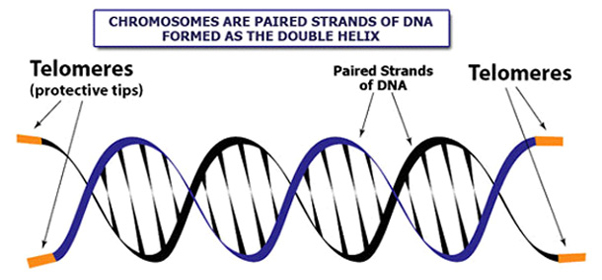Telomere length is vital and plays an instrumental role in how we age and has been linked with certain illnesses and diseases such as cancer. The length of telomeres are considered a biological indicator of age and, “shorter telomeres have been found in many age related diseases such as diabetes, cardiovascular disorders, and neurodegenerative diseases” (Boccardi and Paolisso 2014). Telomeres are the caps of repetitive amino acid chains of the sequence “TTAGGG” and these amino acid chains get shorter with each replication. They are found at each ends of a DNA strand and protects the chromosome like an aglet protects a shoelace. This protection mechanism ensures cells do not divide endlessly. After many divisions, the telomeres reach a critical point which is when telomerase is triggered. The telomerase activity begins because of cell division and helps to regrow the telomere to a healthy size.
Telomerase is the enzyme associated with maintaining telomere length. Without telomerase, telomeres would not be able to repair or regrow themselves to a healthy length. This would result in the organism having a much shorter lifespan because they would be more susceptible to different illnesses and diseases, as well as cellular aging. When a telomere becomes too short, the cell stops replicating and dies via apoptosis. Telomerase ensures telomeres do not reach this threshold thus preventing apoptosis. The critical shortening of these telomeres is found to trigger, “local dysfunction [and] also anticipates the onset of age-associated diseases…” and is “associated with cancer development, primarily through the induction of genomic instability.” (Carneiro et al 2016; Barczak et al 2016). The decreasing telomere length is normal and limits the number of times the same DNA strand can replicate. These both indicate that as one ages and their somatic cells undergo extensive cellular division, they are at a greater risk for cancer.
When telomerase becomes dysfunctional and is no longer able to restore telomeres to their healthy length, the immune system’s leukocyte response is significantly lowered. With a lowered leukocyte response, there are more health concerns regarding disease contraction and development. Somatic cells that have shortened telomeres, “secrete proinflammatory signals that contribute to the prevalence of… cancer, and Alzheimer’s disease at advanced ages” (Mitteldorf 2013). Leukocytes eliminate carcinogenic cells, therefore, the dysfunctional immune response would be unable to produce the leukocytes, in turn causing an increased risk and development of cancer cells.
Telomeres are crucial in protecting the ends of DNA strands while the enzyme telomerase restores telomere length. Without telomeres, DNA ends are left unprotected and the risk of developing diseases increase. This demonstrates that telomeres, “are considered molecular timekeepers determining cellular lifespans.” and that somatic cells are at risk of contracting diseases due to DNA damages and lack of protection (Carneiro et al 2016). Telomeres decrease in length with each replication and the dysfunction of telomeres is normally seen with aging (Carneiro et. al 2016). Developing these disease can be life threatening and can decrease life expectancy. Telomere length, its rate of shortening and other health factors combined are important in assessing longevity.
